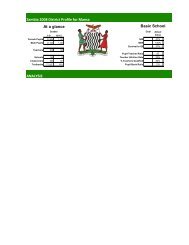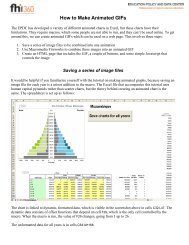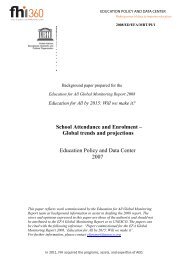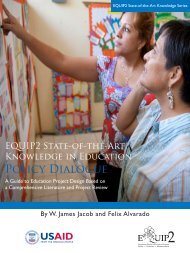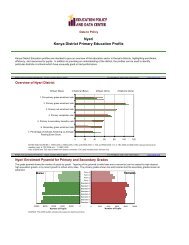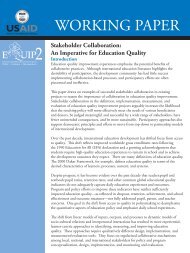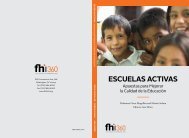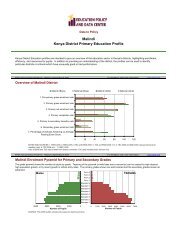EQUIP2 Final Report.pdf - Education Policy Data Center
EQUIP2 Final Report.pdf - Education Policy Data Center
EQUIP2 Final Report.pdf - Education Policy Data Center
Create successful ePaper yourself
Turn your PDF publications into a flip-book with our unique Google optimized e-Paper software.
28<br />
teacher quality, fostering demand and support for education reforms,<br />
decentralizing systems, and improving data quality.<br />
<strong>EQUIP2</strong> Leader Award <strong>Final</strong> <strong>Report</strong><br />
The second report in 2010 showed that between 2003 and 2009, the three<br />
EQUIP LWA awards received 69 associate awards in 41 countries with a<br />
total value of $783,997,740 in funding from various USAID missions and<br />
bureaus. The awards were geographically diverse, with the greatest number<br />
in Sub-Saharan Africa, followed by the Latin American and the Caribbean<br />
region, the Middle East, Asia, and Europe and Eurasia. The three most<br />
prominent themes across EQUIP projects were: policy (90 percent of<br />
projects); developing and strengthening systems (83 percent); and public<br />
demand and support (79 percent). Thirty seven percent of USAID funding<br />
to the EQUIPs was allocated to two thematic areas: instructional quality (19<br />
percent) and systems development and strengthening (18 percent). Fortysix<br />
percent of the funding was dedicated to four thematic areas: policy (12<br />
percent), school or institutional management and leadership (12 percent),<br />
public demand and support (11 percent) and curriculum and materials<br />
development (11 percent).<br />
According to the education policy expert team, the patterns report had the<br />
most impact internally among the EQUIP Leader awards and USAID. For<br />
the Leader awards, the study made it possible to identify technical trends that<br />
could in turn inform the research agenda. In addition, some members of the<br />
education policy expert team felt that the study had considerable influence<br />
on the direction of USAID’s strategic priorities. Demonstrating the breadth<br />
of USAID’s education work across the many thematic areas may have helped<br />
influence the current, more focused education strategy.<br />
School Fees Abolition<br />
In 2005, a new movement swept the international education development<br />
field: the School Fee Abolition Initiative. An active policy issue in the U.S.<br />
and the broader donor community, the removal of school fees was widely<br />
seen as a silver bullet to achieve <strong>Education</strong> for All goals. There was also<br />
pressure within the U.S. Congress to channel significant USAID education<br />
funds into the movement. However, at the time, little was known about<br />
the medium- and long-term impact of school fees elimination on school<br />
quality, or the dynamic within communities and schools regarding education<br />
finance. Preliminary evidence indicated that the elimination of school fees led<br />
to quickly rising enrollment, yet school quality deteriorated just as rapidly.<br />
Furthermore, school fees were only one of many barriers to schooling.<br />
Therefore, USAID was compelled to examine more comprehensive strategies<br />
in order to get the most vulnerable children into schools, keep them there,<br />
and ensure that they learn.




